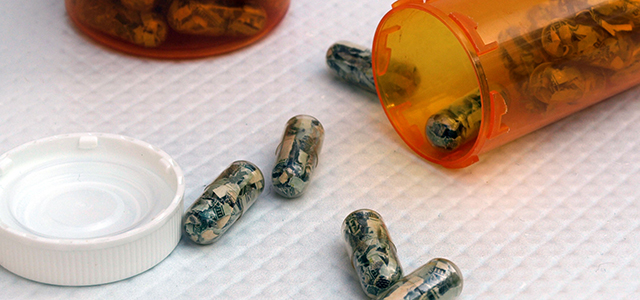Blog
Pharma, healthcare's 8-ton gorilla, comes under increasing scrutiny

For all the heavy weights in the healthcare industry, that industry that now gobbles about one fifth of the U.S. economy, none has more weight to throw around than the pharmaceutical giants.
Big drug companies make the most profit, mark up their prices the most, have the most clout in Congress and with other elected officials, and generally get whatever they want.
But public pressure on the price gouging on drugs is now ratcheting up.
This past week after Gildead Sciences, a U.S. biopharmaceutical company, agreed to discount its $1,000 a pill hepatitis C drug Sovaldi in Germany, a number of mainstream U.S. healthcare journalists raised again the question of why should U.S. drug companies give discounts in other countries that are not available in the U.S.
FiercePharma, an industry website, noted that drug price deals in Germany and the United Kingdom are “closely watched in other countries” that expect similar price breaks. And further that Gildead continues to face heavy “pressure” from developing nations “to provide its vaunted treatments to poor patients at accessible prices.” [Source: FiercePharma.com]
Developing nations, and HIV/AIDS activists in particular, have been protesting price gouging by the drug kings for years.
Doctors Without Borders also took aim at two of the biggest drug giants GlaxoSmithKline and Pfizer in a report in mid-January calling on the two firms to reduce the price of a new vaccine against pneumococcal disease needed by children in the developing world. “Because of the astronomical cost of new vaccines, many governments are facing tough choices about which deadly diseases they can afford to protect their children against,” said the group in its report. [Source: TheGuardian.com]
The heat from that report prompted the world’s richest man Bill Gates, who counts on a philanthropic reputation in developing nations to soften his corporate image, felt compelled to speak out in defense of big pharma. “Criticism by health campaigners of the high prices of some vaccines only serves to deter pharmaceutical companies from working on life-saving products for poor countries,” was how London’s Guardian newspaper summed up Gates’ views. [Source: TheGuardian.com]
It’s hard to shed too many tears for the drug companies. In 2013 alone, the 25 wealthiest giants racked up more than $100 billion. Johnson and Johnson set the pace with more than 13.8 billion in profit, according to data from Thomson ONE Banker.
That buys a lot of clout. Especially in the U.S. where the drug lobbyists have for years killed off proposals to allow Medicare, for example, to negotiate discount drug prices the way countries with national health systems do.
In his new book on the Affordable Care Act, “America’s Bitter Pill,” journalist Steven Brill, cites research showing that overall prescription drug prices are 50 percent higher for comparable products than in other developed countries.
By 2012, more than $280 billion was being spent annually on prescription drugs in the U.S. “If Americans paid what other countries did for the same products, they would save about $94 billion a year,” Brill wrote.
Brill also describes his personal experience with Celebrex, a drug used for arthritis and other muscle and joint pains. Brill found that his insurer paid Pfizer, which makes Celebrex, $50 for each pill. In 2013, he continues, Pfizer “actual incremental cost of producing and shipping its products, before counting expenses for marketing, overhead or research and development, was 18.6 percent, yielding a gross profit margin of 81.4 percent.” In his case, that meant Pfizer was making a profit of $38.40 on each of his $50 pills.
Drug companies typically seek to justify their high charges by, in particular, claiming that they need exorbitant profits to cover their costs for risky research and development of new, more effective drugs.
But an internal National Institutes of Health (NIH) document, the advocacy group Public Citizen reported in 2001, “exposed that taxpayer-funded scientists conducted 55 percent of the research projects that led to the discovery and development of the top five selling drugs in 1995.” [Source: Citizen.org]
As legendary consumer advocate Ralph Nader puts it, “Americans built the drug industry, and the gratitude of the drug companies is to charge them more than in any other countries.” Americans pay the price twice, first in subsidizing the publicly funded research and development and then in paying the highest prices.
And when it came to drafting the Affordable Care Act, this 800-pound gorilla looked every bit like an 8-ton gorilla – and got almost everything on its agenda.
Among the big players in the healthcare industry who were in the deal making from the outset, Brill noted, PhRMA, the lobbying arm for the drug giants, was “first to the table.”
PhRMA was successful in achieving essentially all of its demands, including protecting the 2003 Medicare prescription drug deal which required the government to pay 106 percent of what the drugmakers reported was their ‘average wholesale price,’ which Brill aptly termed “a straitjacket that cost taxpayers $40 billion a year.
PhRMA also succeeded in getting Obama administration support to kill proposed amendments to the ACA that would have allowed consumers to buy drugs from Canada that could produce savings of 30 to 50 percent on medications, Brill noted. Other concessions to the drug kings would follow.
One symptom of the legacy, the aforementioned Sovaldi. A Washington Post blogger, Brill reminds us, speculated that California might have to spend more buying Sovaldi for its Medicaid beneficiaries than it currently does on all K-12 and higher education.”
If some heat on big pharma is beginning to boil now, it is long overdue.
Chuck Idelson is the Director of Communications for National Nurses United